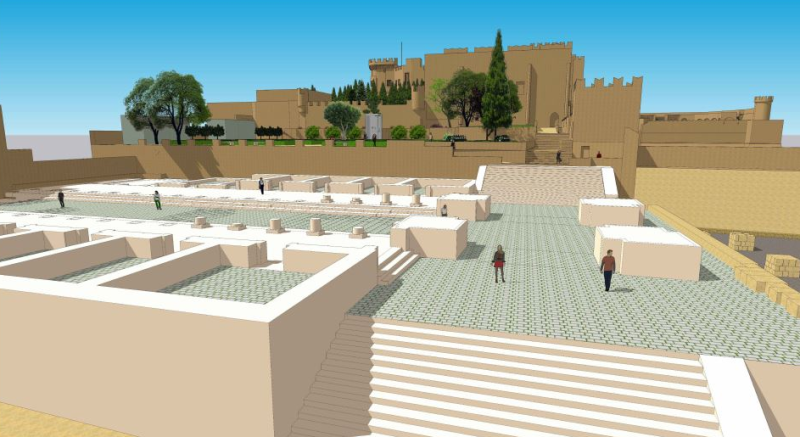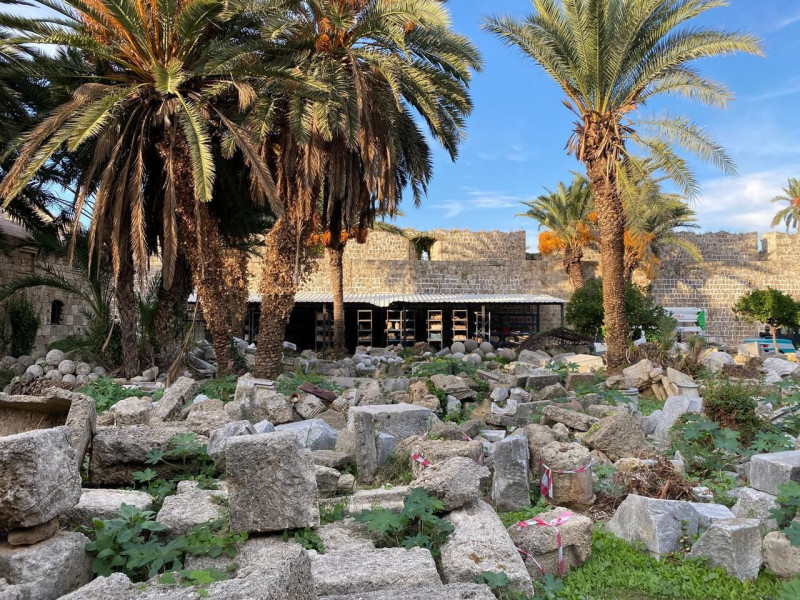Works to highlight and shape the archaeological site of the “Pervola”, which surrounds the ancient youths and the medieval gardens of the Grand Master’s Palace.
An open-air timeless museum is taking shape in the heart of the Medieval City of Rhodes, in the context of the project of highlighting and shaping the archaeological site of the “Pervola”, which surrounds the ancient youths and the medieval gardens of the Grand Master’s Palace.
As the Minister of Culture Lina Mendoni stated, “”Pervola” is a very important archaeological site, in direct contact with the gardens of the Grand Master’s Palace, which preserves archaeological remains dating back thousands of years. Until today, the site has remained unrevealed and unvisited. It is the only monument in which the ancient streetcar of the city of Rhodes is visible and which saves, to a large extent, its building material.
These are the remains of the ancient neorios and the procession road with the monumental Tetrapylos. The promotion of this monumental ensemble and its functional connection with the gardens of the Palace of the Grand Master, which extend on different platforms, creating an open-air timeless museum, covering an area of approximately 18 acres, on the basis of an integrated design for the promotion of the Medieval City of Rhodes .
Based on the specific approved Plan, all the necessary studies are being prepared so that the archaeological site of “Pervola”, included in the UNESCO zone, and the ancient building remains of the youths can be connected with the medieval gardens of the Kastello, creating a single timeless historical monumental core in Medieval City.
The project protects the individual monuments and enhances their legibility. Accessibility is improved by connecting the different levels, creating a new timeless archaeological destination for sightseeing, walking and leisure.
The archaeological site of “Pervola” extends to the northern part of the walled Medieval City of Rhodes, defined by the street of the Knights and the medieval fortifications – between the Tower of Saint Peter and the newer Gate of Liberty – and in direct contact with the medieval gardens of the Grand Master’s Palace.
The museological study foresees the organization of an exhibition in the area of the ancient youth and the medieval gardens of the Grand Master’s Palace and the creation of an open-air Sculpture Gallery in the Medieval City of Rhodes.
The goal is the maintenance, formation and promotion of a wider timeless archaeological site and the connection of important monuments to each other through a documented educational leisure route. Central to the tour route, the secondary routes and the route for visitors with mobility problems, as the area is mostly made accessible to people with disabilities, are the proposed stops at different levels: Medieval fortifications, Church of St. Demetrius of Piossasco , Outdoor Sculpture Gallery, Ancient Neoria – of the “Little Port”, the Military port of Ancient Rhodes (today’s Mandraki), one of the five ports that the city had – Tetrapylo. All levels are connected by stairs, ramps and two elevators. A service and information facility for visitors is also planned at the entrance, in Symi Square. Outdoor seating is available in selected locations. The production of informational, supervisory material, also in Braille, and the production of informational signs is foreseen. It is proposed to design and build shelters in which perishable and other important finds will be exposed.
The tour covers an area of approximately 18 hectares and is developed on five distinct platforms. It starts at the level of the archaeological remains of the Hellenistic and Roman times – ancient neoria of the war port of Ancient Rhodes and the complex of the Roman Tetrapylos with the intersecting streets – and ends at the “Governor’s Gardens”, at the highest level, as it was during the reconstruction of the monument. The sculptures of the medieval times will be exhibited there. At the lowest level of the archaeological site is the Knight’s Hospital. It is proposed the partial restoration of the ancient stairs of the Tetrapylos in order to increase its legibility, and the construction of a new above-ground staircase that will lead and limit the movement of visitors to the upper platforms towards the Palace. The visitor will be given the opportunity, passing outside the Palace, to continue the tour to the west and end up at the Ramachon, which today remains unrevealed and inaccessible to the public. The second and third levels are dominated by the restored medieval historical buildings, such as the Knight’s Mint, with their surrounding area.
The integration of ancient, medieval and more recent building ruins, monuments and also mobile monuments in an archaeological walk includes 17 stops that correspond to specific thematic units. The mobile findings to be exploited amount to 345 exhibits, individually or as a whole. These are stone finds, which include columns, tombstones and non-tombstones, sarcophagi and ossuary, enclosures, pedestals, altars, architectural members, sculptures and other material that falls under the category of public life and funerary practices. The archaeological material supports 11 of the 17 thematic units. The material in question is only a small sample of the numerous material – more than 12,000 finds – that have been collected over the last 80 years during the excavations of the Ephorate of Antiquities.
A part of the “Pervola”, specifically the “Gardens of the Governor” is dedicated to the people of Rhodes and to the thousands of visitors to the island, on Tuesday, June 4, by the Minister of Culture Lina Mendoni.
Source :Skai
I am Frederick Tuttle, who works in 247 News Agency as an author and mostly cover entertainment news. I have worked in this industry for 10 years and have gained a lot of experience. I am a very hard worker and always strive to get the best out of my work. I am also very passionate about my work and always try to keep up with the latest news and trends.












